Kassel power plant - district heating through sewage sludge co-incineration
Apr 11, 22
Kassel power plant - district heating through sewage sludge co-incineration
A plant for the co-incineration of sewage sludge was installed at the Kassel power station in 2016.
It comprises two sewage sludge reception bunkers of 60 m³ each with a sliding-frame extraction system, double-shaft bunker discharge screw conveyors, KOS 1080 HP high-density solids pump, hydraulic power pack and a sewage sludge storage silo with a capacity of 1000 m³, a sliding-frame extraction system, silo discharge screw conveyors and double-shaft precompression screw conveyor, KOS 1470 HP high-density solids pump and hydraulic power pack. Upon leaving the storage silo, the sewage sludge is pumped through a DN 150 delivery line, which leads through the existing plant, towards the circulating fluidised-bed combustion system.
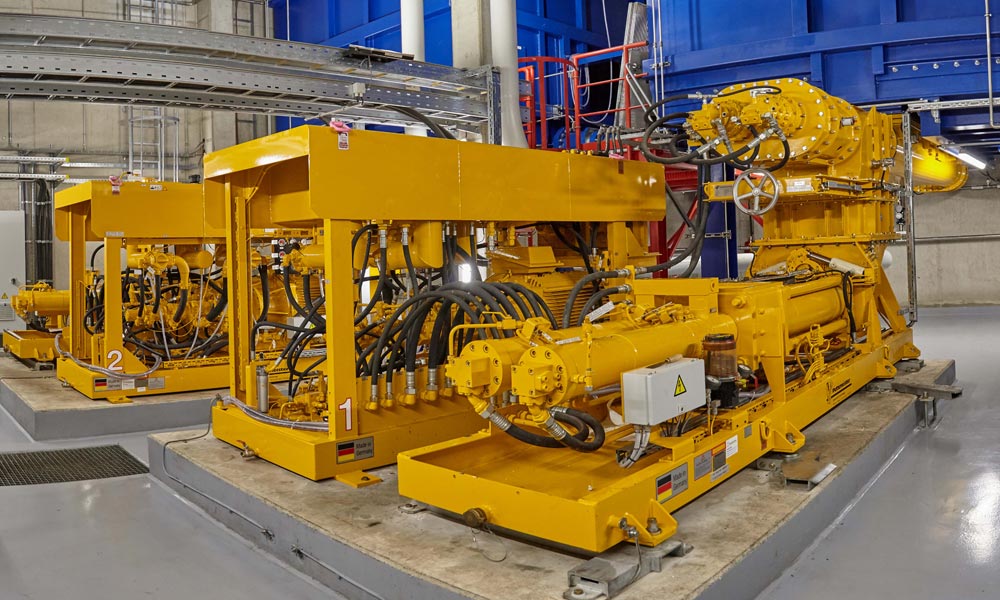
Two sewage sludge reception bunkers of 60 m³ each with sliding-frame extraction system, double-shaft bunker discharge screw conveyors, KOS 1080 HP high-density solids pump
The plant is currently in operation from November through to March, when houses are being heated and district heating is required. Approximately 60,000 tons of sewage sludge are processed during this period. The aim is to deliver carbon-neutral district heating by 2030. Sewage sludge is considered to be carbon neutral, so burning it contributes to the reduction of carbon dioxide.
Sewage sludge pumping trials as basis for decision
In the run up to the project, the power station operating company was able to benefit from a Putzmeister test plant in order to test the effect of sewage sludge co-incineration on the incineration process and also to gain a better planning foundation for the overall system to be designed.
Putzmeister has had very good experiences with this type of test plant in many other projects. Such a test plant enables the operating company to better estimate the specific impact of sewage sludge co-incineration on the overall process. It makes it possible to test system limits and gain insights that enable well-founded decisions for a better planning process.
Proven system
The power station management visited several reference plants for sewage sludge handling during the planning phase, for example the Staudinger power station near Frankfurt. This power station has been successfully operating a Putzmeister plant since 2004. The high profitability of the plant and the excellent service offered by the Putzmeister branch in Gründau were why the team in Kassel also decided to go with Putzmeister. The plant is now operating with an excellent availability of 98%, as Plant Manager Dr Gudrun Stieglitz confirmed. The cooperation between Putzmeister and the operating company during the construction phase also went very well. Despite the complicated silo transport by road – requiring a detour of more than 900 km through three different federal states due to low overhead clearances – the plant was commissioned as scheduled.
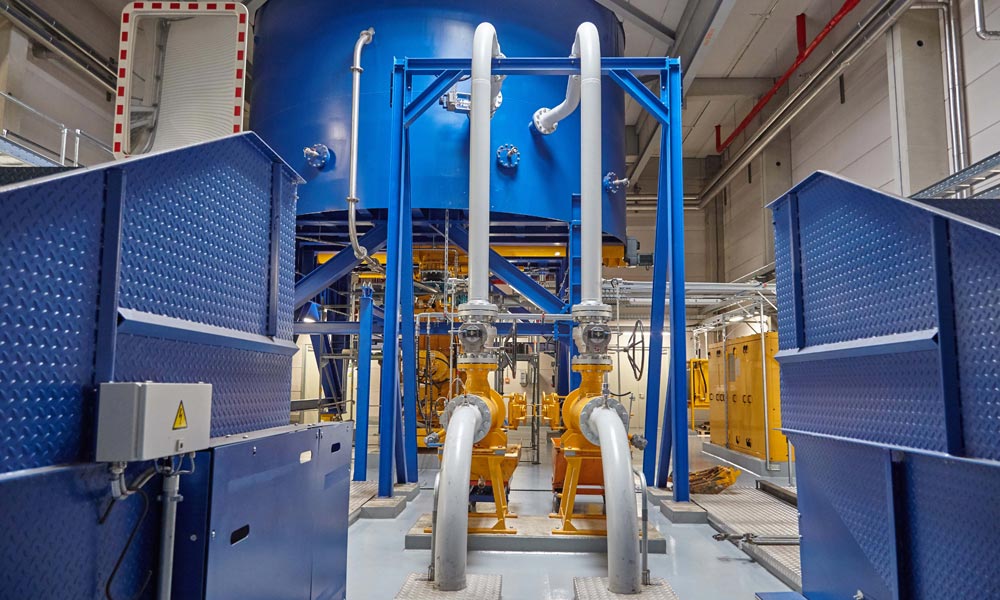
Foreign body separation upstream of the feed into the 1000 m³ storage silo Reception bunker and sliding frame in the reception bunker Sliding frame drive on the storage silo
Plant concept
Putzmeister has once again implemented its proven system comprising a combination of reception bunkers and storage silos. Two steel reception bunkers were supplied into which two trucks each can unload their cargo directly. This offers the benefit of being able to identify whether the sewage sludge contains impurities that could lead to faults downstream at the very start of the process chain. The low capacity of the two reception bunkers makes it possible to match any introduced impurities to the relevant supplier, which in turn significantly reduces the introduction of impurities in the long term.
This “educational effect” has not only been confirmed by the operating company in Kassel, but also by all other operating companies of sewage sludge plants who are operating this Putzmeister reception bunker system. In comparison to a steel reception bunker with a capacity of approx. 50 m³, an anonymous concrete reception bunker of several hundred cubic metres that is drained with a crane offers no insights into which supplier is responsible for any impurities. As there is no opportunity to “educate” said suppliers, it becomes much more difficult to achieve uncontaminated sewage sludge in the long term. Using the tunnel sliding frame system, which has proven its merit over several decades, made it possible to save space on the construction site and implement the underground bunker in a cost-effective manner. The sliding frames push the sludge to the SHS 3242 SH double-shaft bunker discharge screw conveyors, which then load the KOS 1080 HP high-density solids pumps. The particularly large cross sections of the Putzmeister system enable impurities of up to 160 mm to pass through freely.
With 30 m³/h, the output of the two high-density solids pumps underneath the reception bunkers is designed to ensure that the reception bunkers are available for the next truck as quickly as possible to minimise unnecessary waiting times. The S transfer tube technology of the Putzmeister high-density solids pumps has proven its worth at this point of the sewage sludge handling process in particular, as this is where impurities occur most frequently. There are no interfering contours, such as valve stems or valve discs, in the flow area of the sewage sludge. As a result, impurities can reach the delivery cylinder without blocking the system and are conveyed along, which in turn leads to a very high level of availability. Pumping the sewage sludge through pipelines also solves another problem. The hermetically sealed delivery lines prevent odours from developing and the sludge from being contaminated. They are very easy to adapt to existing building structures and can be routed through the plant without much effort.
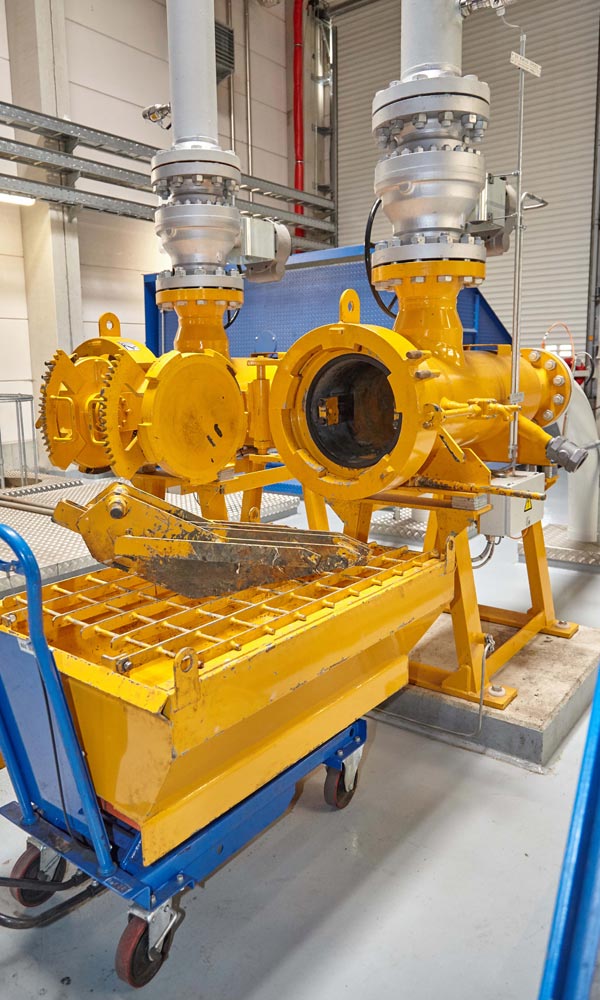
Foreign body trap
The two high-density solids pumps underneath the two reception bunkers feed the joint 1000 m³ storage silo. With a diameter of 8 m and a total height of approx. 24 m, it is one of the largest sewage sludge storage silos in Europe. The use of load cells makes it possible to perfectly determine the fill volume and elegantly transmit the fill level to the control room. When the silo is not being filled, the load cells can also be used to determine the sewage sludge throughput towards the furnace with a great deal of accuracy.
The sewage sludge is also removed from the storage silo with sliding frames. Two single-shaft discharge screws meter the sludge into an intermediate hopper, which is mounted on a double-shaft THS 842 HCB precompression screw conveyor upstream of the KOS 1470 HP high-density solids pump. The specially designed discharge and metering system has already been tried and tested in other very large storage silos and has proven to be the right technology in Kassel as well.
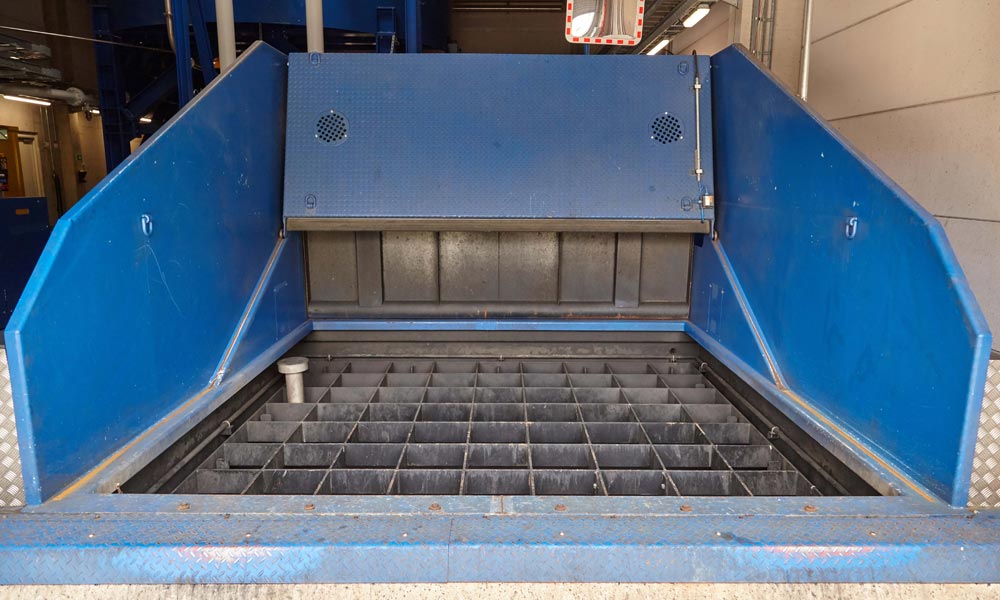
Sewage sludge reception bunker with A-style folding cover from Putzmeister
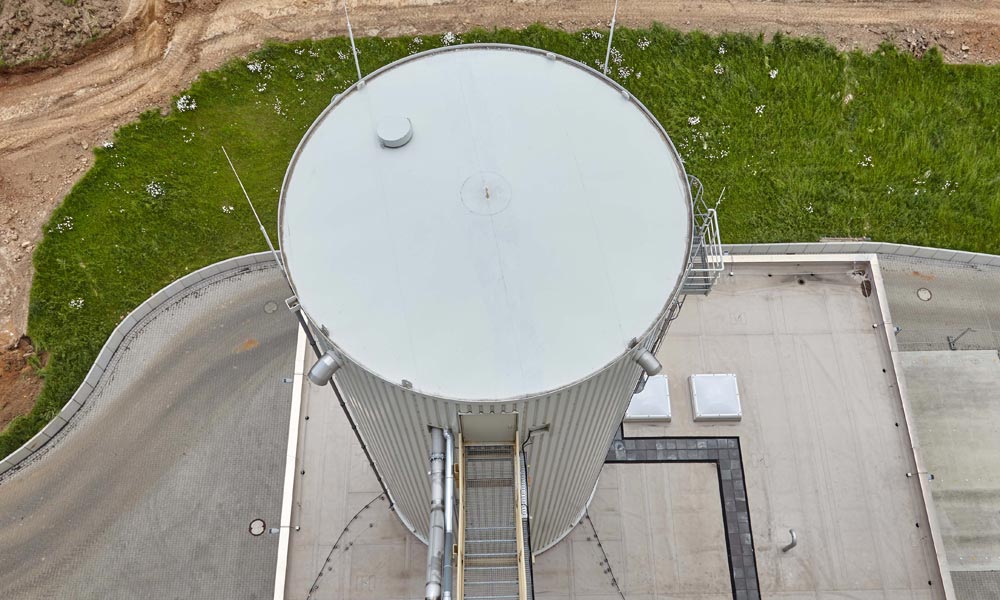
The 1000 m³ storage silo with a diameter of 8 m and a total height of approx. 24 m is one of the largest sewage sludge storage silos in Europe
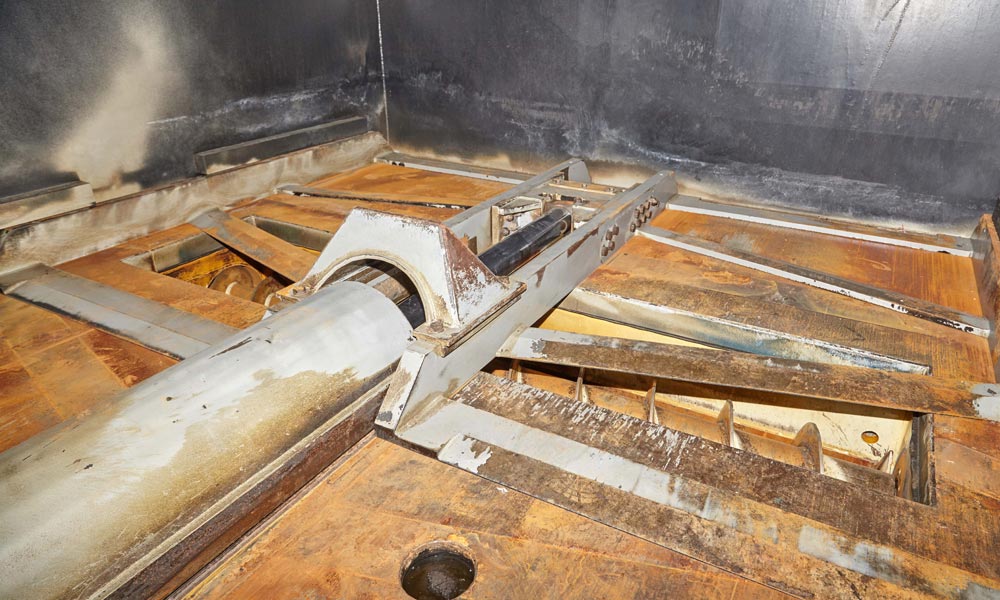
Reception bunker and sliding frame in the reception bunker
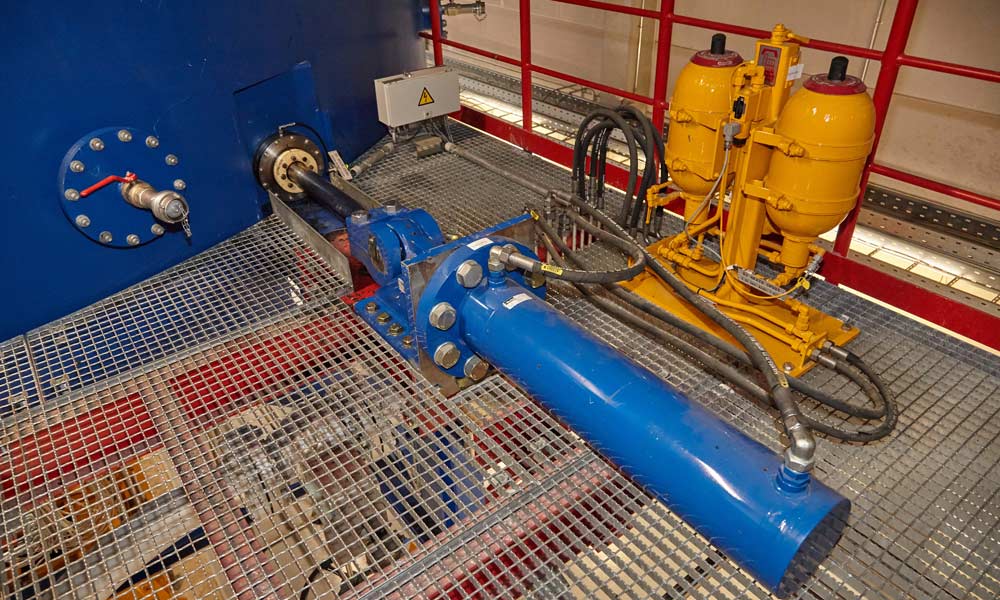
Sliding frame drive on the storage silo
The circulating fluidised bed furnace, which is approximately 60 m away, is loaded directly from the storage silo. The delivery rate is individually adjusted to the process depending on the maximum possible additional power and fluctuates between 20 and 30 m³/h.
The site also plans to operate a sewage sludge drying system in future. A special cycle valve system for distributing the sludge between the furnace and drying system will be installed for this purpose, which is intended to enter operation in autumn 2020.

Technical Data;
| 2 | sewage sludge reception bunkers | 60 m³ each |
|---|---|---|
| 2 | sliding-frame extraction systems | PDL 3535 |
| 2 | Doppelwellige Bunkeraustragsschnecken | SHS 3524 SH |
| 2 | High-density solids pumps | KOS 1080 HP |
| 2 | Hydraulic power packs | HA 200 E-SP |
| 1 | Sewage sludge storage silo | 1.000 m³ / diameter of 8.0 m |
| 1 | Sliding-frame extraction system | PDSF 8000/2 |
| 1 | Silo discharge screw conveyors | SHS 4041 SE |
| 1 | Double-shaft precompression screw conveyor | THS 842 HCB |
| 1 | High-density solids pump | KOS 1470 HP |
| 1 | Hydraulic power pack | HA 200 E-SP |